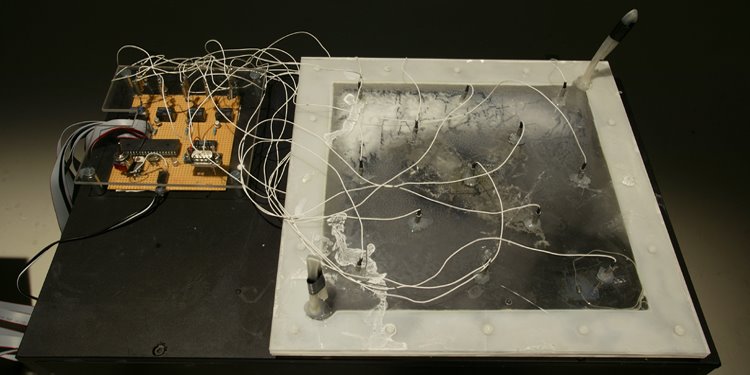By Steve Connor, Science Editor, The Independent
Thursday, 6 March 2008
The ability to read someone's mind and even to visualise their dreams has come a step closer with a study showing that it is possible to predict accurately what someone is seeing by analysing their brain activity with a medical scanner.
Scientists have built a computer that can "decode" the brain activity signals from a scanner and match them to photographs of what a person has seen. In the future, they believe the technology will be able to reconstruct scenes being visualised in a person's head – whether real or imaginary. Tests of the decoder show that it can predict which photograph someone is looking at with an accuracy of up to 90 per cent, although the success rate falls as the total number of photographs being assessed increases.
The scientists believe that it might be possible in the near future to adopt the same approach in making a device that can read someone's thoughts, although they warn against doing this surreptitiously or against someone's will.
"It is possible that decoding brain activity could have serious ethical and privacy implications downstream in, say, the 30 to 50-year time frame. It is something I do care about," said Professor Jack Gallant of the University of California, Berkeley, who led the study published in the journal Nature.
More.
Research and Practice explores practice-based research in art, craft and design.
RECOMMENDED READING
- Allen, Stan. Practice: Architecture, Technique and Representation. Amsterdam: G+B Arts International, 2000.
- Balkema Anette and Slager, Henk: Artistic Research, Special volume of Lier & Boog Series of Philosophy of Art and Art Theory, vol. 18, Amsterdam 2004.
- Bibliography on supervision, research training, and research in art and design
- Biggs, M. (2004) "Learning from Experience: approaches to the experiential component of practice-based research" in: Forskning, Reflektion, Utveckling. Stockholm, Vetenskapsrådet, 6-21.
- Biggs, Michael. Foundations of practice-based research: proceedings of the research into practice conference
- Buchanan, R. “Declaration by Design: Rhetoric, Argument, and Demonstration in Design Practice” in Margolin, Victor ed. (1989) Design Discourse: History, Theory, Criticism (Chicago and London: University of Chicago Press).
- Buchanan, Richard. "Rhetoric, Humanism, and Design." In Discovering Design: Explorations in Design Studies, edited by Richard Buchanan and Victor Margolin, 23-68. Chicago: University of Chicago Press, 1995.
- Chenail, Ronald J. “But is it research?”
- Churchman C. W. (1971) The Design of Inquiring Systems: Basic Concepts of Systems and Organization. New York: Basic Books Inc.
- Cross, Nigel. "Design Research: A Disciplined Conversation." Design Issues 15, no. 2 (Summer 1999): 5-10.
- Cross, Nigel. "Discovering Design Ability." In Discovering Design, edited by Richard Buchanan and Victor Margolin, 105-120. Chicago: University of Chicago Press, 1995.
- Frayling, Christopher. "Research in Art and Design." Royal College of Art Research Papers 1, no. 1 (1993-4): 1-5.
- Hanulla, Mika, Suoranta, Juha & Vadén, Tere. Artistic Research – theories, methods and practices, Art Monitor, Gothenburg 2005. “Introduction”, p. 9-22 and “Artistic Research in Practice”, p. 109-118
- Hughes, Rolf. "Experience and Communication" in Reflections 7 (Brussels: Sint-Lucas School of Architecture, 2007)
- Hughes, Rolf. "The Art of Displacement: Designing Experiential Systems and Transverse Epistemologies as Conceptual Criticism." In Footprint Issue # 4, Spring 2009, Agency in Architecture: Reframing Criticality in Theory and Practice
- Klein, J. T. (2004) “Interdisciplinarity and complexity: An evolving relationship” E:CO Special Double Issue Vol. 6 Nos. 1-2.
- Kuhn, T. S. (1970) The Structure of Scientific Revolutions, 2nd. ed., Chicago: Univ. of Chicago Press.
- Leavy, P. (2009). Method meets art: Arts-based research practice. New York: Guilford Press.
- Mazé, Ramia, and Johan Redström. "Difficult Forms: Critical Practices in Design and Research." In Proceedings of the conference of the International Association of Societies of Design Research. Hong Kong: IASDR, 2007.
- Mazé, Ramia. Occupying Time: Design, Technology and the Form of Interaction. Stockholm: Axl Books, 2007.
- Mäkelä, Maarit and Routarinne, Sara, eds. The art of research : research practices in art and design. Helsinki, Finland: UIAH, 2006.
- Ryle, G. (1949) The Concept of Mind. Harmondsworth: Penguin Books.
- Schön, D. (1981) The Reflective Practitioner. New York: Jossey-Bass.
- Shales, Ezra: “Technophilic Craft”, American Craft Magazine, April/May 2008.
- Simons, H. W., ed. (1990) The Rhetorical Turn: Invention and Persuasion in the Conduct of Inquiry (Chicago and London: University of Chicago Press)
- Talkin' Loud and Sayin' Something (catalogue)
Dendritic computer

by Pablo Miranda and Arijana Kajfes
Vannevar Bush, As we May Think (1945)
The difficulty seems to be, not so much that we publish unduly in view of the extent and variety of present day interests, but rather that publication has been extended far beyond our present ability to make real use of the record. The summation of human experience is being expanded at a prodigious rate, and the means we use for threading through the consequent maze to the momentarily important item is the same as was used in the days of square-rigged ships.
But there are signs of a change as new and powerful instrumentalities come into use...
But there are signs of a change as new and powerful instrumentalities come into use...
Links
About Me
- Rolf Hughes
- Writer & critic; Guest Professor in Theory and Practice-Based Research at the Department of Interdisciplinary Studies at Konstfack University College of Arts, Crafts and Design, Stockholm; Senior Professor in Research Design at the Sint-Lucas School of Architecture, Brussels & Ghent; Senior Researcher at the Royal Institute of Technology, School of Architecture, Stockholm.